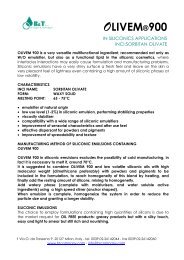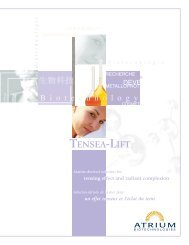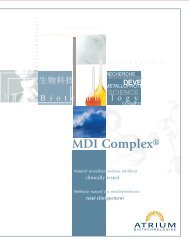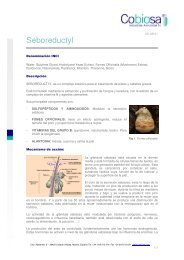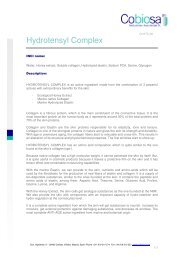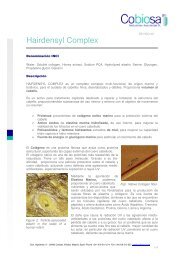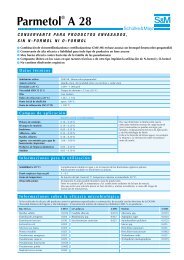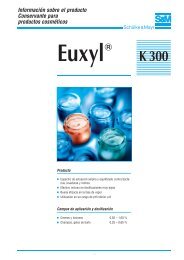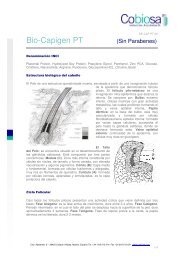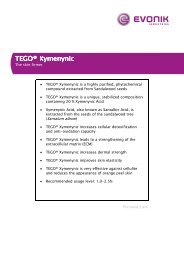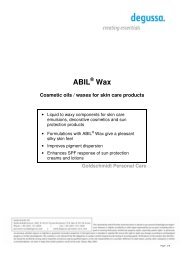TEGO Care 450_e - Quetzal Quimica
TEGO Care 450_e - Quetzal Quimica
TEGO Care 450_e - Quetzal Quimica
You also want an ePaper? Increase the reach of your titles
YUMPU automatically turns print PDFs into web optimized ePapers that Google loves.
• Substances with specific properties, such as<br />
UV filters, plant extracts, protein derivatives<br />
and moisturisers are well tolerated by the<br />
emulsion.<br />
• <strong>TEGO</strong> ® <strong>Care</strong> <strong>450</strong> is used in slightly acidic to<br />
neutral emulsions, however, slightly alkaline<br />
adjustments are possible (pH 4.5 to 8.5 in<br />
creams, pH 5.5 to 8.5 in lotions).<br />
• The creams and lotions are distinguished by<br />
high stability towards heat and freezing<br />
stress; stability between -25 °C and +50 °C<br />
is attainable.<br />
Preparation<br />
<strong>TEGO</strong> ® <strong>Care</strong> <strong>450</strong> belongs to the group of the so<br />
called lipid emulsifiers. The HLB value of these<br />
emulsifiers is lower in comparison to ethoxylated<br />
emulsifiers.<br />
If the production takes place with the for<br />
ethoxylates common method (add the hot water<br />
phase slowly to the hot oil phase while stirring)<br />
it could happen that a water-in-oil emulsion be<br />
formed (recognizable by high viscosity and<br />
transparent/gel-like appearance). During the<br />
cooling process this emulsion converts to an oilin-water<br />
emulsion with great particle size.<br />
We therefore recommend for the preparation of<br />
creams to heat oil phase and water phase<br />
separately to approx. 65 °C; for lotions oil<br />
phase and water phase are heated separately<br />
to 80 °C.<br />
Furthermore we recommend to add the hot oil<br />
phase to the hot water phase while stirring.<br />
The coarsely dispersed pre-emulsion is then<br />
homogenized.<br />
If the above mentioned processing is not<br />
possible, we recommend to combine the hot<br />
water and oil phase without stirring (to avoid<br />
the building of the water-in-oil form) and start<br />
afterwards with the homogenisation.<br />
During cooling, a constant horizontal and<br />
vertical movement of the emulsion has to be<br />
ensured. The viscosity of the liquid emulsion<br />
increases to a creamy consistency, as the<br />
hydrated consistency promoters solidify.<br />
The dispersion of <strong>TEGO</strong> ® Carbomer 141 or<br />
<strong>TEGO</strong> ® Carbomer 134 in oil (e. g. in mineral oil,<br />
decyl oleate, octyl stearate; not in triglycerides)<br />
is added at 60 °C. Then the emulsion is<br />
homogenized again.<br />
Perfume, temperature-sensitive substances or<br />
electrolyte containing ingredients are added at<br />
35 - 45 °C.<br />
Neutralization of the emulsion is done at<br />
approx. 35 °C.<br />
The particle size of the dispersed oil droplets<br />
of long-term stable emulsions is approx.<br />
1 - 5 µm. More coarsely dispersed emulsions<br />
tend to separate.<br />
Recommended usage concentration<br />
2.0 - 3.0 % <strong>TEGO</strong> ® <strong>Care</strong> <strong>450</strong><br />
Packaging<br />
600 kg pallet (24 x 25 kg)<br />
Hazardous goods classification<br />
Information concerning<br />
− classification and labelling according to<br />
regulations for transport and for dangerous<br />
substances<br />
− protective measures for storage and<br />
handling<br />
− measures in accidents and fires<br />
− toxicity and ecological effects<br />
is given in our material safety data sheets.<br />
Page 3 of 5



